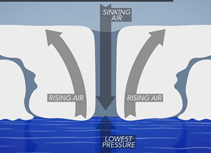

Context
The first cyclone of the season, ‘Extremely Severe Cyclone Mocha’, is brewing in the Southeast Bay of Bengal with favourable atmospheric conditions.
What’s the big deal with this common phenomenon?
- The month of May is conducive for cyclogenesis in the Indian Ocean. Therefore cyclone Mocha's formation is a seasonal pattern. However, what is uncharacteristic is the rapid intensification of these storms.
|
Most vulnerable states prone to cyclonic impact - West Bengal, Andhra Pradesh, Tamil Nadu, Odisha, Puducherry (UT) and Gujarat |
- Intensification of Cyclones: Due to global anthropogenic warming and rise of sea surface temperature in the northern India ocean basins (the Arabian Sea and the BOB), more number of intense cyclones are being witnessed which may increase further.
- Slow cyclones: Another concern is the observed global slowdown (by approximately 10%) of translational speed. Slow cyclones stay over the same area for longer and create more devastation by surges – tides or rain.
What are Cyclones?
- Cyclones in India are powerful weather systems characterized by low-pressure areas accompanied by strong winds and heavy rainfall.
- This wind system rotates inwards (counter-clockwise in the Northern Hemisphere and clockwise in the Southern Hemisphere) around a strong low-pressure centre.
- They are natural phenomena characterized by rotating winds and atmospheric disturbances. In India, cyclones commonly occur in the Bay of Bengal and the Arabian Sea.
|
Low pressure area
|
Formation of Cyclones
|
Factors responsible for cyclone formation -
|
- Creation of low-pressure zone: Warm and moist air over the ocean rises upward due to less density, leaving less air near the ocean surface, as a result, it starts to create a low-pressure zone.
- Formation of cycle: Due to the surrounding high-pressure areas, air flows into this low-pressure and eventually warms up, forming a cycle.
- Growing: With the constant heating rising of the warm air and evaporation process, the entire cloud and wind system starts to spin and grow.
- Eye-formation: With acquiring more speed, the eye of the cyclone starts to form in the centre. This central zone signifies the lowest air pressure area and is calm and clear. Further, the high-pressure air from above flows towards this region.



